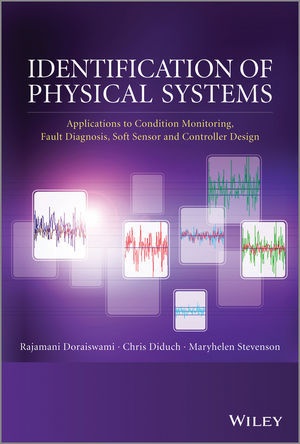Read more
Develops a systematic and a unified approach to the problem of physical system identification and its practical applications There is a need for a book which develops a systematic and a unified approach to the problem of physical system identification and its practical applications.
List of contents
Preface xv
Nomenclature xxi
1 Modeling of Signals and Systems 1
1.1 Introduction 1
1.2 Classification of Signals 2
1.3 Model of Systems and Signals 5
1.4 Equivalence of Input-Output and State-Space Models 8
1.5 Deterministic Signals 11
1.6 Introduction to Random Signals 23
1.7 Model of Random Signals 28
1.8 Model of a System with Disturbance and Measurement Noise 41
1.9 Summary 50
References 54
Further Readings 54
2 Characterization of Signals: Correlation and Spectral Density 57
2.1 Introduction 57
2.2 Definitions of Auto- and Cross-Correlation (and Covariance) 58
2.3 Spectral Density: Correlation in the Frequency Domain 67
2.4 Coherence Spectrum 74
2.5 Illustrative Examples in Correlation and Spectral Density 76
2.6 Input-Output Correlation and Spectral Density 91
2.7 Illustrative Examples: Modeling and Identification 98
2.8 Summary 109
2.9 Appendix 112
References 116
3 Estimation Theory 117
3.1 Overview 117
3.2 Map Relating Measurement and the Parameter 119
3.3 Properties of Estimators 123
3.4 Cramér-Rao Inequality 127
3.5 Maximum Likelihood Estimation 139
3.6 Summary 154
3.7 Appendix: Cauchy-Schwarz Inequality 157
3.8 Appendix: Cram´er-Rao Lower Bound 157
3.9 Appendix: Fisher Information: Cauchy PDF 161
3.10 Appendix: Fisher Information for i.i.d. PDF 161
3.11 Appendix: Projection Operator 162
3.12 Appendix: Fisher Information: Part Gauss-Part Laplace 164
Problem 165
References 165
Further Readings 165
4 Estimation of Random Parameter 167
4.1 Overview 167
4.2 Minimum Mean-Squares Estimator (MMSE): Scalar Case 167
4.3 MMSE Estimator: Vector Case 169
4.4 Expression for Conditional Mean 172
4.5 Summary 183
4.6 Appendix: Non-Gaussian Measurement PDF 184
References 188
Further Readings 188
5 Linear Least-Squares Estimation 189
5.1 Overview 189
5.2 Linear Least-Squares Approach 189
5.3 Performance of the Least-Squares Estimator 195
5.4 Illustrative Examples 205
5.5 Cram´er-Rao Lower Bound 209
5.6 Maximum Likelihood Estimation 210
5.7 Least-Squares Solution of Under-Determined System 212
5.8 Singular Value Decomposition 213
5.9 Summary 218
5.10 Appendix: Properties of the Pseudo-Inverse and the Projection Operator 221
5.11 Appendix: Positive Definite Matrices 222
5.12 Appendix: Singular Value Decomposition of a Matrix 223
5.13 Appendix: Least-Squares Solution for Under-Determined System 228
5.14 Appendix: Computation of Least-Squares Estimate Using the SVD 229
References 229
Further Readings 230
6 Kalman Filter 231
6.1 Overview 231
6.2 Mathematical Model of the System 233
6.3 Internal Model Principle 236
6.4 Duality Between Controller and an Estimator Design 244
6.5 Observer: Estimator for the States of a System 246
6.6 Kalman Filter: Estimator of the States of a Stochastic System 250
6.7 The Residual of the Kalman Filter with Model Mismatch and Non-Optimal Gain 267
6.8 Summary 274
6.9 Appendix: Estimation Error Covariance and the Kalman Gain 277
6.10 Appendix: The Role of the Ratio of Plant and the Measurement Noise Variances 279
6.11
About the author
Rajamani Doraiswami, Professor Emeritus, Electrical and Computer Engineering Department, University of New Brunswick, USARajamani Doraiswami is Professor Emeritus in the Department of Electrical and Computer Engineering at the University of New Brunswick.
Dr. Doraiswami is known internationally as an excellent researcher, has held an NSERC operating grant continually since 1981 and has published more than 60 papers in refereed journals and 90 conference papers. Dr. Doraiswami's research interests focus on control, signal processing, pattern classification and algorithms. One of his most successful collaborations has been in the development of laboratories for the teaching of analysis and design of control and signal processing systems in real-time.
Chris Diduch is a Professor in the Department of Electrical and Computer Engineering at the University of New Brunswick. His research is in the fields of control systems and digital systems.
Maryhelen Stevenson is a Professor in the Department of Electrical and Computer Engineering at the University of New Brunswick. Her research is in the fields of pattern classification, speech and signal processing, adaptive systems and time-frequency representations.
Summary
Identification of a physical system deals with the problem of identifying its mathematical model using the measured input and output data. As the physical system is generally complex, nonlinear, and its input output data is corrupted noise, there are fundamental theoretical and practical issues that need to be considered.

